Writer 作者/ Andy Cohen
Translator 翻译/ Gu Ling 顾灵
“ 喔,夜,喔,最甜美的时候,虽是黑的色调,
但你带来安宁,一切不知疲倦都因你而沉睡…”
——米开朗基罗
“ O night, O sweetest time, though black of hue,
with peace you force all the restless work to end…” ——Michelangelo
中国艺术家胡子的最新画作系列重访了几幅十六十七世纪皇家贵族的肖像画与当时艺术家们的自画像,并将这些画重新创作为极简的、波普的图画,而其背后隐藏着文艺复兴与启蒙时期的暗影——这些年代艺术蓬勃,但奴役未减。如果借用贡布里希“图式与修正”(schema correction)的说法,那胡子对这些西方肖像画“图式”的重访,也即她以自己独特的视觉语言对其所作的“修正”。贡布里希在《艺术与错觉》一书中写道:“艺术家的创作不可能无中生有,但他可以对他的前辈们评头画足。”这些西方艺术史上的著名画作令人仰视,它们反复出现在书籍、博物馆乃至明信片等复制品中,让人看得快麻木了。而胡子的重访,则给了我们新鲜的眼光去重新观看这些画作。In her latest series of paintings, Chinese artist Hu Zi appropriates iconic portraits of 16th and 17th century kings and queens and fellow artists and refigures them into minimalistic, pop-like images tormented by the dark side of the Renaissance and Enlightenment—periods during which both the arts and slavery flourished in tandem. Hu Zi’s renderings of these icons engage in a sort of “schema correction” --to borrow a phrase from EH Gombrich--of western canonical images (the schema) that results in her own original, visual language (the correction). As Gombrich wrote in Art and Illusion, “The artist cannot start from scratch, but he can criticize his forerunners.” Many of these images are so ingrained in the institutionalized western canon--reproduced in art history books and museum postcards ad infinitum--that we have become desensitized to them. Hu Zi’s variations gives us a fresh perspective, and makes us look anew.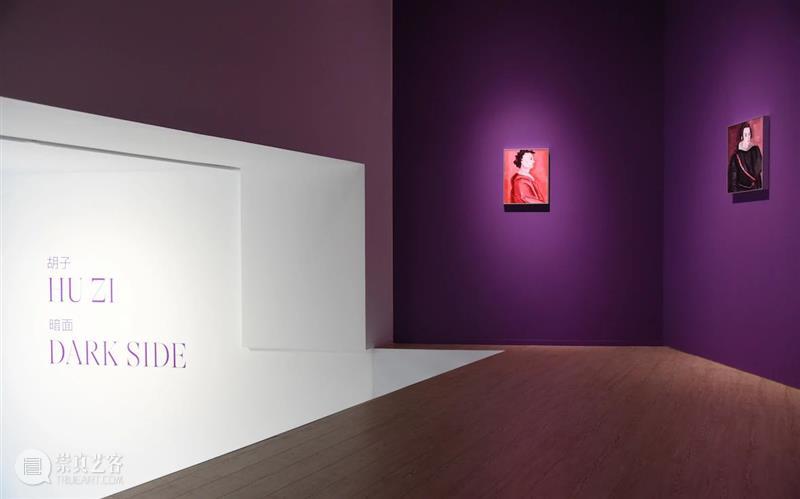
“暗面”展览现场, 2020年, 东画廊, 上海 | View of “Dark Side”, 2020, Don Gallery, Shanghai
胡子画中的线条有棱有角,直来直去。画中人物的边缘轮廓粗钝差互。这种线条强化了画中人物个性的暗面。简单几笔,她便勾勒出米开朗基罗经典的罗马式大鼻子,他抿着的嘴唇,爬着皱纹的额头下一双悲寥的眼睛。无需像原作者达尼埃莱·达·伏尔泰拉(Daniele da Volterra)那样为写实而大费周章,胡子的《摹达尼埃尔的米开朗基罗》(Michelangelo (after Daniele), 2019)是随手捕捉到了一个随意自然的瞬间。
相较原画中模糊抽象的色块,她对这幅画的另一“修正”是一件黑色的衣袍。画中米开朗基罗的左手(他是左撇子)和脸庞就像平整墙面上略略突出的浮雕那样引人瞩目,仿佛在回应米式的名言:“人的走向应该依靠双眼而非双手,因为在双手派上用场之前,先得靠双眼做出判断。”
Hu Zi’s lines are angular, and straight forward. The jagged-edged outlines of her subjects’ physical features reinforce the dark sides of their personalities. With a few simple brush strokes, she conjures Michelangelo’s strong, classic Roman nose, his pursed lips and craggy eyes beneath a furrowed brow, giving the artist a forlorn expression. Instead of the painstaking, realistic reproduction of a studied pose achieved in Daniele da Volterra’s original, Hu Zi’s Michelangelo after Daniele (2019) captures a more spontaneous, simple-stroked moment.
She also adds a black garb, another “correction”, to the amorphous and abstract elements of the original. The left hand (Michelangelo was a lefty) and facial features are the primary detailed features that stand out in stark relief, as if to accent Michelangelo’s famous quote: “It is necessary to keep one’s compass in one’s eyes and not in the hand, for the hands execute, but the eye judges.”
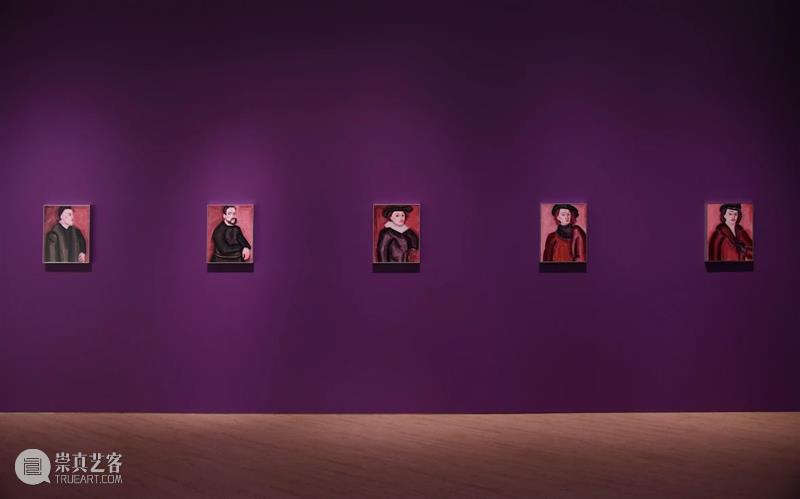 “暗面”展览现场, 2020年, 东画廊, 上海 | View of “Dark Side”, 2020, Don Gallery, Shanghai
“暗面”展览现场, 2020年, 东画廊, 上海 | View of “Dark Side”, 2020, Don Gallery, Shanghai
在《摹提香的提香》(Titian (after Titian), 2019)中,人物的活力也来自双眼与左手。提香的双唇紧闭,双眼圆睁,几乎怒不可遏似地直视这长久以来被他凝视的世界。胡子略去了原作中象征着提香高贵地位的链子和徽章(当时他被国王菲利普二世的父亲封爵),而让我们只关注艺术家最重要的品质:迫切地凝视并灵敏地意识到他之所见。几笔极简的立体线条,她便捕捉到了他脸上的忧虑。菲利普二世订画付他的钱,仰赖于这位国王的远征与奴役。或许,提香永远无法真正接受这个事实。同样的忧虑也出现在胡子摹委拉斯开兹的贵族画像中。在她的笔下,两位西班牙皇家兄弟就像同一个人。崎岖的线条勾勒出唐·卡洛斯王子的下巴、双眼、眉毛和长鼻子,还有他的傲慢与不快乐。画中深深的酒红色以及黑色的管状笔触,都预示着他被注定的噩运。
在《摹委拉斯开兹的菲利普四世》(Philip IV (after Velázquez), 2019)中,胡子把这位国王,卡洛斯王子的哥哥,画得沉静、几乎像一尊雕像。粗钝的线条突出了这位国王臭名昭著的长相,尤其是因近亲婚配而继承的“哈布斯堡唇(下颌前突畸形)”,这让他很不自信。
委拉斯开兹曾这样评价国王菲利普四世:“他的不自信让他几乎对别人言听计从。”胡子笔下的这两兄弟不论是肢体语言还是神情都像一对双胞胎,几乎一样。这两张画像也让人联想到两兄弟及他们家族的死难史——卡洛斯年仅25岁就夭折了,菲利普的长子屈屈16岁便英年早逝,其后菲利普娶了自己的侄女,并生下了体弱多病的查尔斯二世。尽管权力的皇冠因横跨大西洋的贩奴生意而熠熠生辉,但画作的暗黑色调却预示着菲利普国王统治下的西班牙即将迎来政治与军事上的衰败。
In Titian (after Titian) (2019), the subject’s energy again radiates from the eyes and the left hand. Titian’s lips are clenched, and his eyes have the intense, almost angry stare honed from a life of observation. Hu Zi strips the chains and insignia of status (he was knighted by King Philip II’s father) from the original and leaves us with the artist’s most valuable assets: keen observation and the dexterity of realizing what he sees. She captures the worry on his face, again, with her minimal gesture of cubic lines. Perhaps Titian could never reconcile the fact that his patron King Philip II’s art commissions and lavish new buildings in which to house them were financed in part by profits from his slaving expeditions.
The subject’s worrisome outlook can also be seen in Hu Zi’s appropriations of Velázquez’s portraits of the later generation Spanish royal brothers, men she depicts as almost indistinguishable from one another. Through a jagged-lined chin, eyes and brows, and a long nose, she captures the prince Don Carlos’ look of arrogance and unhappiness. The dark blood-burgundy and black tubular strokes foreshadow his doomed destiny.
She paints his brother the king--in Philip IV (after Velázquez) (2019)--with a solemn, almost statuesque bearing. Here the angular lines highlight the king’s notorious rigid external demeanor, but one nonetheless tinged with a self-doubt accentuated by the prominently outlined chin or “Habsburg lip”, a deformity often caused by inbreeding.
According to Velásquez’s observation of King Philip IV, “he mistrusts himself, and defers to others too much.” Hu Zi paints the two brothers in very similar portraits in terms of body language and expression, as if they were twins. The family’s history of death and sadness can be surmised from these two portraits (Carlos was to die at 25, Philip’s first-born son died at 16, after which Philip married his niece who gave birth to the sickly Charles II). The dark tones foreshadow the political and military decline of Spain under King Philip’s rule, even as the Crown prospered from its involvement in the slave trade.
“暗面”展览现场, 2020年, 东画廊, 上海 | View of “Dark Side”, 2020, Don Gallery, Shanghai
在胡子的《摹伦勃朗的伦勃朗1634》(Rembrandt 1634 (after Rembrandt), 2019)中,伦勃朗摆着一副跟王室兄弟俩很像的皇家姿态,但他的心理状态却截然相反。胡子笔下的伦勃朗自信满满,而自信恰恰是兄弟俩所缺少的。伦勃朗的着装与他身后的背景都用了轻盈、轻薄的管状笔触,很像竹子,也很胡子。
在《摹伦勃朗的伦勃朗1633》中(Rembrandt 1633 (after Rembrandt),2019)。原作肖像梦幻般的纯真换成了克制,隐隐透着一股少年戾气。伦勃朗的活跃期也是荷兰的黄金时代,荷兰帝国一边奴役、一边积累财富。胡子的笔触薄而坚定,一笔是一笔,不像原作中笔触几乎隐而不见。相比自相矛盾的统治者,胡子的伦勃朗更有自信。
胡子的《摹理查德森的亚历山大·蒲柏》(Alexander Pope (after Richardson), 2019)既保留了原作中的古典造型,又将这位诗人描绘成一个发型凌乱的朋克摇滚歌手,这双重角色很适合这位驼背且体弱多病的前卫诗人,他在病魔缠身下将古希腊史诗译成了英文。他因信奉天主教而被人排挤,却并没有因重金投资贩奴公司而心有不安。
In Hu Zi’s Rembrandt 1634 (after Rembrandt) (2019), the artist strikes a royal pose physically similar to the brothers, yet with a psychological expression in complete contrast. Here Hu Zi depicts Rembrandt with the self-assured, confident demeanor lacking in both King Philip IV and his brother. The brushstrokes in the background and clothes are cylindrical in form, almost like bamboo, and her brush stroke is uniquely hers, light, thin and tubular.
Hu Zi conjures the artist a year earlier in her Rembrandt 1633 (after Rembrandt) (2019). Gone is the dreamy, innocent look of the original; we now have a look of pent up emotion, verging on adolescent anger. Rembrandt’s works were commissioned during the Dutch Golden Age, a time in which the empire grew ever more wealthy from the backs of slave labor. Hu Zi’s layers of paint are thin, but sure, and each stroke is visible, unlike the original’s in which the brushstrokes seem to disappear. Hu Zi’s Rembrandt appears more confident in his powers than the ambivalent rulers are of theirs.
Hu Zi’s Alexander Pope (after Richardson) (2019) shows the poet with jagged hair, portraying him more of a punk rocker, despite the classical pose--a fitting dichotomy for this avant-garde and sickly, hunch-backed poet who translated the Greek epics while battling disease. Personally discriminated against for being Catholic, Pope nonetheless invested heavily in a slave trading company.
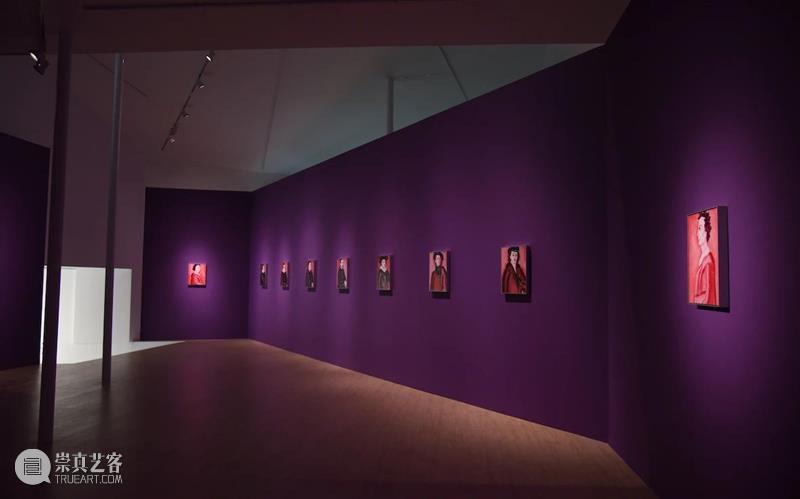
“暗面”展览现场, 2020年, 东画廊, 上海 | View of “Dark Side”, 2020, Don Gallery, Shanghai
在这一系列中,男子肖像都是油画,女子则是水粉。水粉带给画面一抹温柔与女性色彩。两幅女性肖像的原作也是对既有“图式”的“修正”,因为前辈画家们试图用画作来粉饰并“修正”伊丽莎白一世与玛丽·安托瓦内特(法国国王路易十六的王后)在公众眼中的形象。事实上,这两位女性的形象反差鲜明:原作肖像绘制时,伊丽莎白已是一位年届六十、板着面孔的处女,而玛丽·安托瓦内特则被公众视为挥霍无度的荡妇。胡子的《英格兰伊丽莎白一世》 (Elizabeth I of England, 2019)取自小马库斯·吉拉特(Marcus Gheeraerts the Younger)的迪奇雷画像,原作中铺陈着数不清的象征伊丽莎白一世女王权力、指涉日不落大英帝国的符号,而这些符号在胡子的画里全被撤除了。原作中的白昼被胡子画成了黑夜。女王的眼睛就像两颗射出炭黑光线的黑色太阳。墨色的云团完全包裹住了女王,取代了原作背景中一分为二的光明与黑暗。迪奇雷画像中应女王本人要求而柔化的脸部线条在胡子的画中又硬了回来,并加上了空洞的表情与收紧的下巴。被从原作中撤走的还有这句可笑的自我标榜:“她可以复仇,但她没有。” 因为她把自己的亲表侄女、苏格兰女王玛丽判了绞刑。多褶边、饰有夸张的白色轮状皱领的粉紫色裙装与纯黑背景反差明显,但胡子去掉了原作中女王手里的扇子和手套,还把原本女王脚下的世界地图撤走了(地图是原作的另一项“修正”,让女王看上去立世界于足下)。加上那一身臃肿浮夸的装扮,女王显得好像重心不稳,随时可能跌倒。失去了这些荣耀符号的她,看上去有点无助。In this series, Hu Zi paints the men with oil and the women with gouache. The water and ink add a touch of softness and femininity. The original source paintings of Elizabeth I and Marie Antoinette, the “schemas”, are also a “correction” of sorts because the ancient artists sought to refurbish and “correct” both queens’ images in the public eye. But, in fact, the two couldn’t be more diametrically opposed: Elizabeth was known as the dour faced 60-year-old virgin at the time of the portrait, and Marie Antoinette was viewed by the public as a lascivious spend thrift. Hu Zi’s Elizabeth I of England (2019) is appropriated from the Ditchley Portrait painted by Marcus Gheeraerts the Younger, which through myriad symbols showcased the power of the monarchy. In her revision, Hu Zi strips away all symbols and references to the sun and power of the realm so prevalent in the original. In place of light, she paints darkness. The queen’s eyes are like two black suns that radiate blackened rays. Clouds of bleeding black ink completely surround the monarch, replacing the bifurcated light and dark background of the original. Hu Zi hardens the facial features that the Ditchley Portrait originally softened to flatter the queen’s features (as she demanded), while also adding an empty, vacuous expression with a tightened jaw. Also, removed from the original is the line, “She can but does not take revenge.” A ridiculous line of propaganda when one considers Queen Elizabeth beheaded her own cousin, Mary Queen of Scots. The frilly pink-purple dress, complete with elaborate ruffs, stands in contrast to the simple black tones of the background. In three-quarter portrait, Hu Zi chooses to leave the queen empty handed without the comfort of accouterments (the original has her holding a fan and glove). She also removes the world from under her (another “correction” of the original in which Elizabeth stands atop a globe), giving the impression of a monarch unanchored. The virgin queen seems to be on the verge of tipping over by her heavy, pompous dress. Stripped of all symbolism, she seems out of her element and helpless.“暗面”展览现场, 2020年, 东画廊, 上海 | View of “Dark Side”, 2020, Don Gallery, Shanghai
胡子在《玛丽·安托瓦内特在凡尔赛宫》(Marie Antoinette in Versailles, 2019)中继续探索权力、性别与图像创作之间的关系。原作系伊丽莎白·维吉-列布鲁德(Elisabeth Vigee-Lebrund)受委托绘制,意在纠正之前引人非议的王后肖像。那幅是非肖像中的玛丽穿着在当时会被误以为是睡衣的宽松裙装,并在展出当天就从皇家沙龙撤下了,成了当日头条丑闻。为了美化自己的公众形象,打破人们对她风流淫荡、珠光宝气的刻板印象,以及脱掉“赤字夫人”这顶歪帽子,玛丽王后定制了这幅新作。胡子用简单的线条就捕捉到了玫瑰的柔嫩与芬芳,花瓣微张,楚楚动人;低胸紫色裙装则衬托着皇后丰盈饱满的乳房。但也需留意皇后黑色的眼睛(原作中是蓝色的),它们在略微不同的黑色背景前凸显出来。弯折的花茎与背景的黑色共同掩盖了她赠予众人的玫瑰实则多刺。法国人民没有买账,他们对这幅公关肖像嗤之以鼻。胡子的画隐去了许多维吉-列布鲁德的修正细节,包括原作中对自然光晕的引入。胡子模糊了衣服的褶皱与花纹,调暗灯光,将笔调聚焦在即将被送上断头台的法国末代王后玛丽·安托瓦内特那写着不祥预感的、望向宿命的面容。With Marie Antoinette in Versailles (2019), Hu Zi further explores power, gender and the act of image making. The original work, painted by Elisabeth Vigee-Lebrund, was commissioned by the court to rectify an earlier portrait which proved scandalous. It depicted Marie dressed immodestly in a cotton chemise-like dress that society considered more of an undergarment. The painting was removed from the Salon of the Académie Royale which further fed into the negative gossip of the day. Marie Antoinette wanted to improve her public image, tarnished by rumors of sexual scandal and her lavish lifestyle, an image that garnered her the moniker “Madame Deficit”. With simple lines Hu Zi captures the soft texture and fragrance of roses, the liveliness of their open petals; and with another line the sumptuous bosom, held in check by the low-collared purple dress.But also note the blackness of the queen’s eyes (in the original they were blue), reinforced by the nuanced tonality of the black background. Together with jagged edged stems, these changes belie that the rosy image she is offering to the people is full of thorns. The French citizenry did not buy into her attempt at trying to purify her image. Hu Zi further rectifies Vigee-Lebrund by stripping away much of her detail, including the section of natural light in the original. By obscuring the frilliness, and darkening the light, she focuses on the ominous, fateful expression of the soon-to-be guillotined Marie-Antoinette, the last queen of France.“暗面”展览现场, 2020年, 东画廊, 上海 | View of “Dark Side”, 2020, Don Gallery, Shanghai
胡子的三幅自画像是整个系列中的最后的水粉画。《穿着橙色皮衣的自画像》(Self-Portrait with Orange Leather, 2020)与本系列中所有其他正面肖像对比鲜明,因为胡子侧着头,她的头发遮住了她的眼睛。不过,这种隐藏同时也是一种显露。观者透过她的耳朵、鼻子、嘴和手的轮廓,拼出了一幅关于艺术家个性的肖像。三幅画分别就像一部电影里的三帧画面,从还能看到她左手捏着一根烟的远景镜头递进到了头部特写。如果把黑色的背景、黑色的头发与T恤对应她个性中的暗部,那阳光般的橙色皮衣、明亮的双手和脸部皮肤就是在表现她个性的亮部。看似羞涩的胡子,走在影子的深处,直直的黑发是她藏身的帘幕,黑发任随心意可开可合;透过这独属于她的窗子,观察着。这些自画像等待着后世的艺术家来“修正”,一如她修正了十六十七世纪的这些历史肖像。她在2018年的展览画册《Stone Flesh》中写道:“肖像,你赋予他们生命,他们有各种的命运。”这些国王与王后肖像的黑色背景含蓄地指涉着这些横跨大西洋的殖民帝国经营的奴役与贩奴生意,而委托艺术家的资金来源于此。委拉斯开兹本人也曾有过一个奴隶。回望历史,诸如启蒙运动与文艺复兴这样的词似乎都成了带有美好幻想的误名“图式”,需要被重新审视与“修正”。“启蒙”与“复兴”恰恰建立在非人道的奴役体制之上。所以,诸如理性时代(the Age of Reason)与人文主义(Humanism)这些道貌岸然的时代划分或许未能揭示、反倒掩饰了那些时代黑暗与残酷的全部真相。光明与黑暗,昼与夜,阴与阳贯穿着人类的全部历史,也潜含于人类存在的本质,而今,它们同社会对其暗面洗白的需要,一同溶解在了胡子的这批新作中。
The final gouache in the series is Hu Zi’s self-portrait triptych, Self-Portrait with Orange Leather (2020). Here, in striking contrast to the depictions of overt facial expressions in all the other portraits of this series, Hu Zi hides her own eyes behind her hair. This concealment is nonetheless revealing. The viewer is left to put together the puzzle of her personality through the minimalistic lines of her profiled ear, nose, mouth and hand. The works in the triptych are like film frames that zoom out from a close-up to full body shot in which we see her hand holding a marijuana joint. The blackness of the background, hair and shirt reinforce the dark side, while the sun-orange leather coat, her hands and facial features offer a glimpse of the lighter side of her personality. Seemingly shy, Hu Zi sits back in the shadows and hides behind the curtain of her straight black hair, which she can open and close at will, observing through her private window.
Hu Zi leaves plenty in her self-portrait for future artists to “correct”, as well as in her rectified portraits of historical icons from the 16th and 17th centuries. “You pour lives into the portraits, and they will live their own,” she wrote for her 2018 exhibition catalogue, Stone Flesh.Hidden in the Dark Side of these portraits is the implicit fact that these kings and queens were totally engaged in the colonial enterprise which helped finance artists in their domestic cultures. Velázquez even owned a slave. In this current environment of reckoning with history, appellations such the Enlightenment, and the Renaissance seem to be misnamed “schemas” which also need to be re-evaluated and “corrected”. The virtuous sounding periodization nomenclature like the Age of Reason and Humanism doesn’t seem to reflect the true state of those times. Light and darkness are as common to every period of human history as they are to each day and night--the Yin to the Yang. Hu Zi’s latest body of work embraces the underlying bipolar nature of human existence. “暗面”展览现场, 2020年, 东画廊, 上海 | View of “Dark Side”, 2020, Don Gallery, Shanghai

上海市徐汇滨江龙腾大道2555号D馆
Hall D, 2555 Longteng Avenue, West Bund, Shanghai
参观时间:
周二-周六 10:00-18:00,周日 13:00-18:00
Visiting hours:
Tue-Sat 10:00-18:00, Sun 13:00-18:00
+86 21 6473 1533
www.dongallery.cn
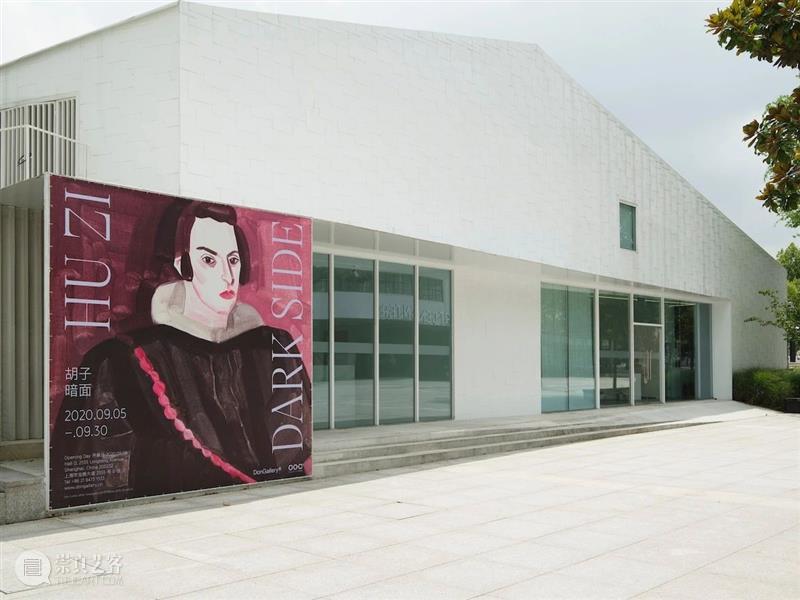
媒体联络 Media Contact
info@dongallery.com.cn



 “暗面”展览现场, 2020年, 东画廊, 上海 | View of “Dark Side”, 2020, Don Gallery, Shanghai
“暗面”展览现场, 2020年, 东画廊, 上海 | View of “Dark Side”, 2020, Don Gallery, Shanghai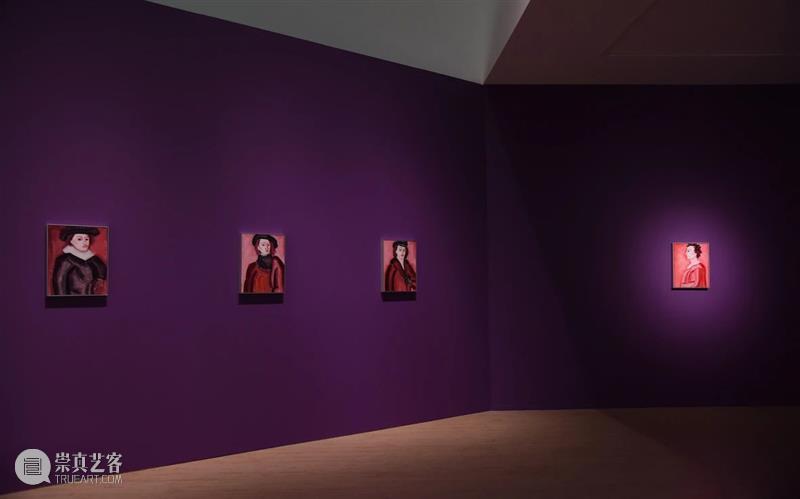

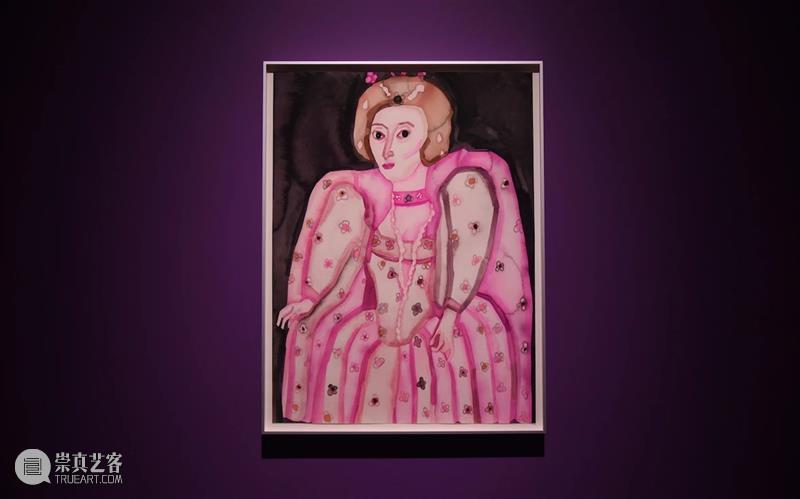
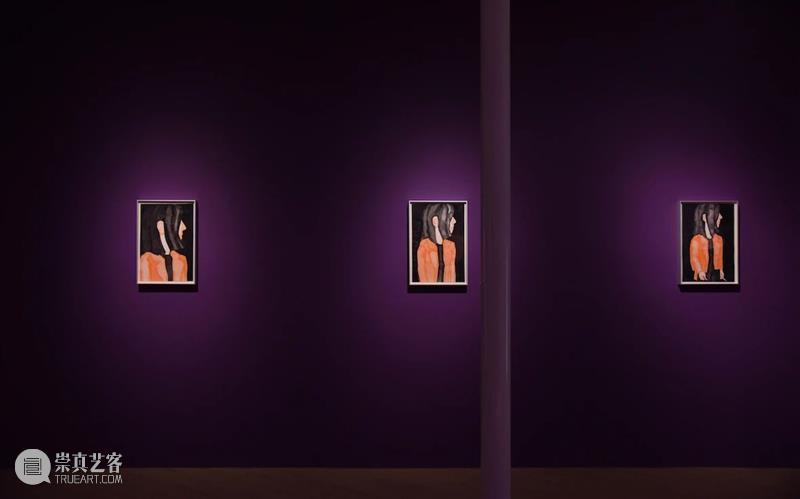
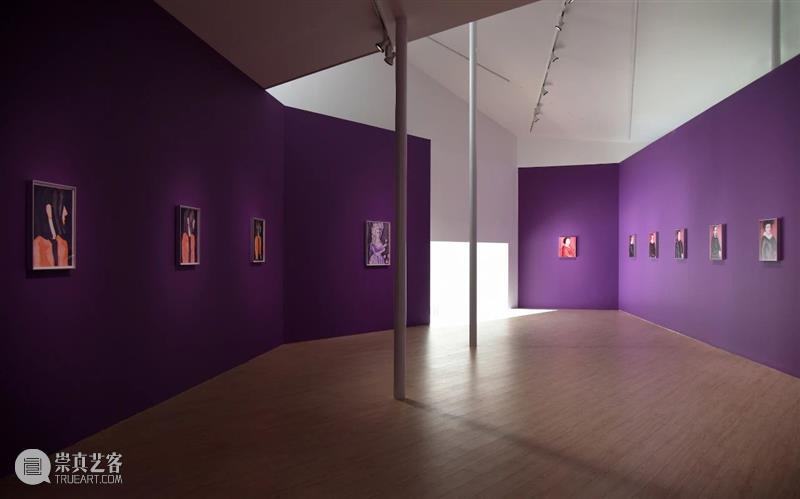










 分享
分享